Want to see your plant grow tall and strong instead of sprawling around? Learn how to train Monstera to climb walls like a pro!

Monstera is an air-purifying plant, so imagine if it climbs your walls and grows big—it can make your house look more tropical and beautiful?
Since it naturally loves climbing trees, you can train your Monstera to climb like a pro right in your home with these tips!
How to Train Monstera to Climb Walls Like a Pro
Do you know that the National Garden Bureau has declared that 2025 is officially the ‘Year of the Monstera’ in Pennsylvania? Good news if you’re a fan of this aroid!
Now, if you’re feeling more inspired, how about making use of its tall stature and exotic foliage to create a statement indoors? With the help of this post–guide it to trail up the walls in your room and create a perfect indoor jungle-like setting.
1. Give It a Good Climbing Buddy
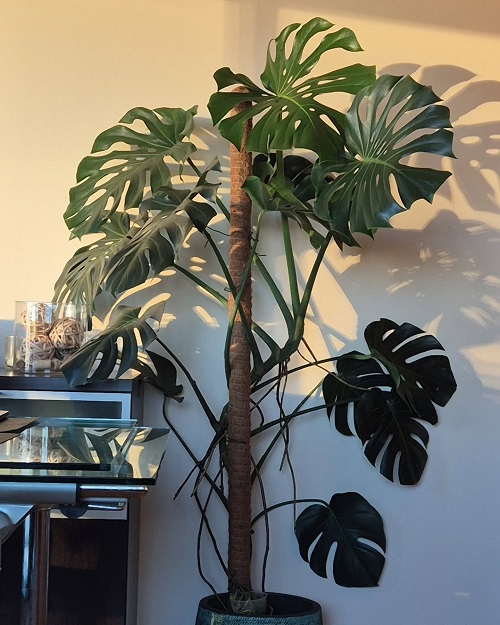
Every climbing Monstera needs a solid friend to lean on in the beginning! To start, grab a moss pole, a wooden trellis, or even a lattice panel to guide the plant’s growth upward. Have a look!
- Trellis, cords, or wireframe: Simply stick one into the pot or garden bed and gently tie the stems to it using soft twine or plant ties.
- Moss poles: These are a natural and stylish option. The moss’s texture gives the roots a perfect grip. Don’t forget to mist it often—this helps the aerial roots attach more quickly.
- Coir poles: These are sturdy supports for your Monstera, wrapped in natural coconut fiber (coir), which mimics the plant’s natural climbing environment hence perfect for your leafy friend to latch onto and flourish.
- Lattice panel: It provides a large, flat surface for the plant to climb. A lattice panel is especially effective for creating a dense living wall or backdrop for your artistic mind.
Tip: Monstera varieties like Adansonii, Deliciosa, Mini Monstera, and Dubia love to climb and thrive with proper support!
2. Guide Its Growth with Wall Hooks
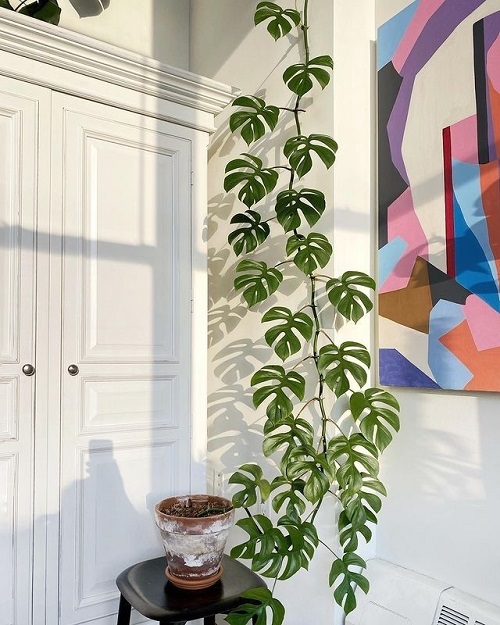
If you’re not growing Monstera deliciosa but other smaller varieties like adansonii or Mini Monstera, then it’s better to guide them with wall hooks and clips to direct the stems and provide extra support.
Over time, the stems will start to attach themselves to the wall with their aerial roots, but before that happens, you need to show them the way!
By means of a few hooks along the wall, you can guide the stems upward. Once they’re in place, gently secure the trailing stems with soft ties. As your plant grows, add more hooks or clips to keep the new growth on track.
Bonus Hack: You can use clear or stylish hooks to match or contrast your wall. This will keep your Monstera setup looking tidy and attractive.
3. A Strong Pot Is a Key
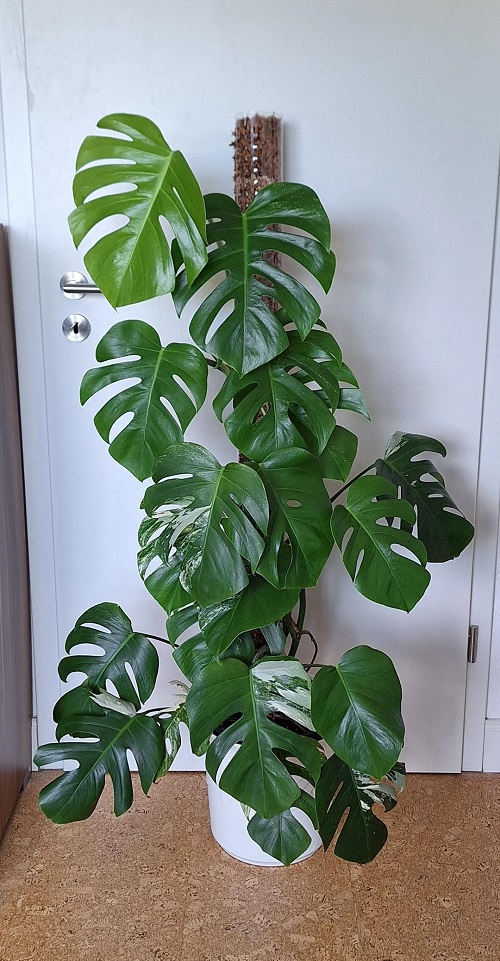
While planning, don’t miss this important step—the pot is the source of nutrients and minerals. Choose a pot with a quality potting mix to provide enough space and nutrients for healthy root and stem growth.
Pick a heavy pot like a ceramic one—anything that isn’t lightweight or likely to topple over when it becomes a beast. Stability is essential, especially for Monstera deliciosa, which grows large.
Also, avoid using shallow pots, as they won’t provide enough stability. Look for pots with drainage holes to prevent root rot.
4. Blend Support with Your Decor
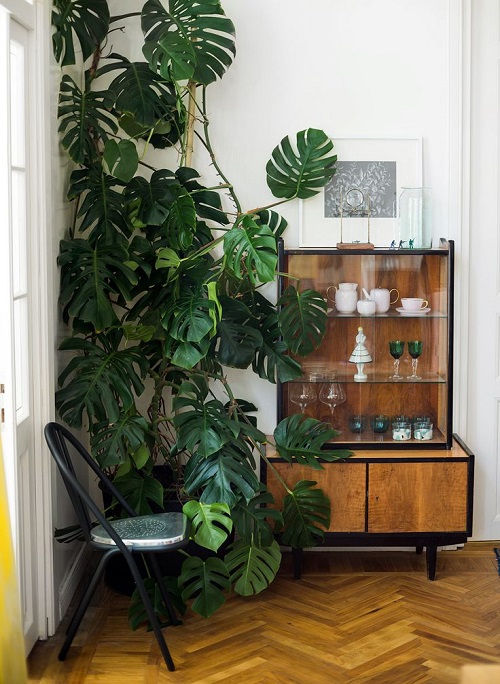
Choose a material that goes well with your interior or exterior decor to bring out an extra aesthetic appearance. For example, you can experiment with colors—consider contrasting shades or matching them with your decor theme.
Plus, textures like wood and metallic can go together nicely. You can even experiment with DIY supports made from bamboo and driftwood or try ropes and macrames to give a rustic look.
To make things even more interesting, you can wrap some fairy lights around it, and your evenings will feel magical!
A Few Things to Keep in Mind
5. A Good Feed for Better Growth
Monsteras love nutrient-rich, peat-based soil with good drainage. You can use a mix with perlite, shredded bark, or sand for better aeration. Fertilize during the growing season with a balanced fertilizer, like 10-10-10 or 20-20-20.
High concentrations of N-P-K can damage the plant, so use fertilizers with caution. To avoid over-fertilizing, mix it with water to dilute it to half strength and apply it every 4 to 6 weeks.
6. Watering Done Right
Water your Monstera when the top 2 inches of soil feel dry. This way, you’ll avoid overwatering, which can lead to root rot, and underwatering, which can make the plant unhappy.
You can use room-temperature water to avoid shocking the roots. Also, mist the plant occasionally to replicate its natural tropical environment and boost humidity.
If you follow these watering habits, your Monstera will always stay happy and healthy!
7. Smart Use of Light
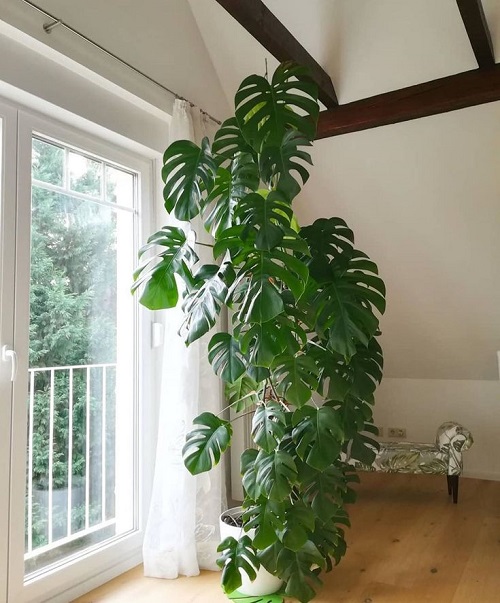
Good lighting is a must for your Monstera to climb happily. Choose a spot with bright, indirect sunlight. Too much shade can make the plant leggy with not-so-lush leaves, and too much direct sun can scorch it.
An east-facing window is just right for giving it the perfect amount of light, if you’re placing near a Southern or Western direction, ensure the sunlight is filtered in the afternoon.
The most important for a Monstera that is so not so big is to rotate its pot occasionally to ensure all sides get enough light, follow these tips for better understanding. Fluorescent grow lights can also work wonders if your space doesn’t have great natural lighting.
This vining houseplant loves climbing so much that you might catch it trying to take over your bookshelf or chandelier! Also, keep caution with Monstera deliciosa clinging to your walls.
If you keep up with the things mentioned here, then in no time, your Monstera will be soaring to tremendous heights with beautiful trails to show off to your guests and Instagram!


